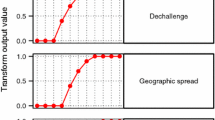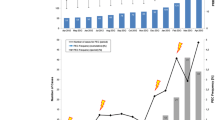Abstract
Background: Improving the detection of drug safety signals has led several pharmacovigilance regulatory agencies to incorporate automated quantitative methods into their spontaneous reporting management systems. The three largest worldwide pharmacovigilance databases are routinely screened by the lower bound of the 95% confidence interval of proportional reporting ratio (PRR02.5), the 2.5% quantile of the Information Component (IC02.5) or the 5% quantile of the Gamma Poisson Shrinker (GPS05). More recently, Bayesian and non-Bayesian False Discovery Rate (FDR)-based methods were proposed that address the arbitrariness of thresholds and allow for a built-in estimate of the FDR. These methods were also shown through simulation studies to be interesting alternatives to the currently used methods.
Objective: The objective of this work was twofold. Based on an extensive retrospective study, we compared PRR02.5, GPS05 and IC02.5 with two FDR-based methods derived from the Fisher’s exact test and the GPS model (GPSpH0 [posterior probability of the null hypothesis H0 calculated from the Gamma Poisson Shrinker model]). Secondly, restricting the analysis to GPSpH0, we aimed to evaluate the added value of using automated signal detection tools compared with ‘traditional’ methods, i.e. non-automated surveillance operated by pharmacovigilance experts.
Methods: The analysis was performed sequentially, i.e. every month, and retrospectively on the whole French pharmacovigilance database over the period 1 January 1996–1 July 2002. Evaluation was based on a list of 243 reference signals (RSs) corresponding to investigations launched by the French Pharmacovigilance Technical Committee (PhVTC) during the same period. The comparison of detection methods was made on the basis of the number of RSs detected as well as the time to detection.
Results: Results comparing the five automated quantitative methods were in favour of GPSpH0 in terms of both number of detections of true signals and time to detection. Additionally, based on an FDR threshold of 5%, GPSpH0 detected 87% of the RSs associated with more than three reports, anticipating the date of investigation by the PhVTC by 15.8 months on average.
Conclusions: Our results show that as soon as there is reasonable support for the data, automated signal detection tools are powerful tools to explore large spontaneous reporting system databases and detect relevant signals quickly compared with traditional pharmacovigilance methods.






Similar content being viewed by others
References
van Puijenbroek EP, Bate A, Leufkens HGM, et al. A comparison of measures of disproportionality for signal detection in spontaneous reporting systems for adverse drug reactions. Pharmacoepidemiol Drug Saf 2002 Feb; 11(1): 3–10
Evans SJ, Waller PC, Davis S. Use of proportional reporting ratios (PRRs) for signal generation from spontaneous adverse drug reaction reports. Pharmacoepidemiol Drug Saf 2001 Nov; 10(6): 483–6
Bate A, Lindquist M, Edwards IR, et al. A Bayesian neural network method for adverse drug reaction signal generation. Eur J Clin Pharmacol 1998 Jun; 54(4): 315–21
Norén GN, Bate A, Orre R, et al. Extending the methods used to screen the WHO drug safety database towards analysis of complex associations and improved accuracy for rare events. Stat Med 2006 Nov 15; 25(21): 3740–57
Szarfman A, Machado SG, O’Neill RT. Use of screening algorithms and computer systems to efficiently signal higher-than-expected combinations of drugs and events in the US FDA’s spontaneous reports database. Drug Saf 2002; 25(6): 381–92
DuMouchel W. Bayesian data mining in large frequency tables, with an application to the FDA spontaneous reporting system. Am Stat 1999 Aug; 53(3): 177–90
DuMouchel W, Pregibon D. Empirical bayes screening for multi-item associations. In: Proceedings of the Seventh ACM SIGKDD International Conference on Knowledge Discovery and Data Mining. San Francisco (CA): ACM, 2001: 67–76 [online]. Available from URL: http://portal.acm.org/citation.cfm?id=502526 [Accessed 2010 Mar 26]
Benjamini Y, Hochberg Y. Controlling the false discovery rate: a practical and powerful approach to multiple testing. J R Stat Soc Series B Stat Methodol 1995; 57(1): 289–300
Ahmed I, Dalmasso C, Haramburu F, et al. False discovery rate estimation for frequentist pharmacovigilance signal detection methods. Biometrics 2010 Mar; 66(1): 301–9
Ahmed I, Haramburu F, Fourrier-Reglat A, et al. Bayesian pharmacovigilance signal detection methods revisited in a multiple comparison setting. Stat Med 2009 Jun 15; 28(13): 1774–92
Ahmed I, Thiessard F, Miremont-Salame G, et al. Pharma-covigilance data mining with methods based on false discovery rates: a comparative simulation study. Clin Pharmacol Ther 2010 Oct; 88(4): 492–8
Roux E, Thiessard F, Fourrier A, et al. Evaluation of statistical association measures for the automatic signal generation in pharmacovigilance. IEEE Trans Inf Technol Biomed 2005 Dec; 9(4): 518–27
Matsushita Y, Kuroda Y, Niwa S, et al. Criteria revision and performance comparison of three methods of signal detection applied to the spontaneous reporting database of a pharmaceutical manufacturer. Drug Saf 2007; 30(8): 715–26
Almenoff JS, LaCroix KK, Yuen NA, et al. Comparative performance of two quantitative safety signalling methods: implications for use in a pharmacovigilance department. Drug Saf 2006; 29(10): 875–87
Lehman HP, Chen J, Gould AL, et al. An evaluation of computer-aided disproportionality analysis for post-marketing signal detection. Clin Pharmacol Ther 2007 Aug; 82(2): 173–80
Lindquist M, Stahl M, Bate A, et al. A retrospective evaluation of a data mining approach to aid finding new adverse drug reaction signals in the WHO international database. Drug Saf 2000 Dec; 23(6): 533–42
Hauben M, Madigan D, Gerrits CM, et al. The role of data mining in pharmacovigilance. Expert Opin Drug Saf 2005 Sep; 4(5): 929–48
Hochberg AM, Hauben M, Pearson RK, et al. An evaluation of three signal-detection algorithms using a highly inclusive reference event database. Drug Saf 2009; 32(6): 509–25
Hochberg AM, Hauben M. Time-to-signal comparison for drug safety data-mining algorithms vs. traditional signaling criteria. Clin Pharmacol Ther 2009 Jun; 85(6): 600–6
Alvarez Y, Hidalgo A, Maignen F, et al. Validation of statistical signal detection procedures in eudravigilance post-authorization data: a retrospective evaluation of the potential for earlier signalling. Drug Saf 2010 Jun 1; 33(6): 475–87
Thiessard F. Détection des effets indésirables des médicaments par un système de génération automatisée du signal adapté à la base nationale de pharmacovigilance [in French; thesis]. Bordeaux: Université Victor Segalen Bordeaux 2, 2004
Thiessard F, Roux E, Miremont-Salamé G, et al. Trends in spontaneous adverse drug reaction reports to the French pharmacovigilance system (1986–2001). Drug Saf 2005; 28(8): 731–40
Miller GC, Britt H. A new drug classification for computer systems: the ATC extension code. Int J Biomed Comput 1995 Oct; 40(2): 121–4
Brown EG, Wood L, Wood S. The medical dictionary for regulatory activities (MedDRA). Drug Saf 1999 Feb; 20(2): 109–17
Ahmed I, Poncet A. PhViD: an R package for pharma-covigilance signal detection [online]. Available from URL: http://cran.r-project.org/web/packages/PhViD/index.html [Accessed 2012 Mar 29]
R Development Core Team. R: a language and environment for statistical computing [online]. Vienna, 2011. Available from URL: http://www.R-project.org [Accessed 2012 Mar 29]
Bégaud B, Evreux JC, Jouglard J, et al. Imputation of the unexpected or toxic effects of drugs: actualization of the method used in France. Therapie 1985 Apr; 40(2): 111–8
Acknowledgements
This work was supported in part by IRESP (Institut de Recherche en Santé Publique) grant A06076LS. The authors have no conflicts of interest that are directly relevant to the content of this study.
Author information
Authors and Affiliations
Corresponding author
Rights and permissions
About this article
Cite this article
Ahmed, I., Thiessard, F., Miremont-Salame, G. et al. Early Detection of Pharmacovigilance Signals with Automated Methods Based on False Discovery Rates. Drug Saf 35, 495–506 (2012). https://doi.org/10.2165/11597180-000000000-00000
Published:
Issue Date:
DOI: https://doi.org/10.2165/11597180-000000000-00000




